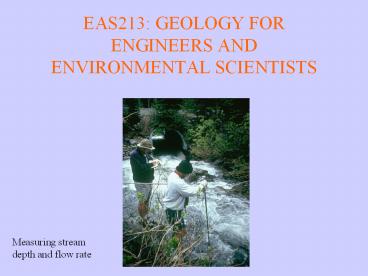EAS213: GEOLOGY FOR ENGINEERS AND ENVIRONMENTAL SCIENTISTS - PowerPoint PPT Presentation
1 / 17
Title:
EAS213: GEOLOGY FOR ENGINEERS AND ENVIRONMENTAL SCIENTISTS
Description:
... is on applied aspects of earth science, visible or regional scale features, and ... Earth Scientists: 1) surveying and mapping of the surface of the earth ... – PowerPoint PPT presentation
Number of Views:62
Avg rating:3.0/5.0
Title: EAS213: GEOLOGY FOR ENGINEERS AND ENVIRONMENTAL SCIENTISTS
1
EAS213 GEOLOGY FOR ENGINEERS AND ENVIRONMENTAL
SCIENTISTS
Measuring stream depth and flow rate
2
The focus of EAS213 is on applied aspects of
earth science, visible or regional scale
features, and short-term processes
3
APPLICATIONS forEngineers and Earth
Scientists 1) surveying and mapping of the
surface of the earth2) assessing rock and
mineral resources3) analyzing earthquake
patterns, risk, building codes, tsunamis4)
assessing volcanic risk5) managing fresh water
resources6) evaluating human impacts on
environment due to development, mining,
combustion of fossil fuels, air and water
pollution
4
FEATURES from microscopic to global size, but
emphasizing hand specimen to regional scales (1cm
to 100 km)
5
PROCESSES need to be measurable or observable
over periods of seconds to thousands of years
6
Satellite data analyzed to produce a vegetation
map
7
Topographic map showing contours of equal
elevation in meters. Field elevation locations
(purple dots) were interpolated using the linear
spline method.
8
Mapping of Faults Catskills
9
(No Transcript)
10
Mineral Resources
The element Carbon produces the softest mineral
(graphite) or the hardest mineral (diamond)
depending on its crystal structure.
11
Ore Minerals/Mining
12
Transform Plate Boundary San Andreas Fault
13
1989 Loma Prieta earthquake
14
Mt St Helens Erupts
15
Surface drainage pattern of a river
16
(No Transcript)
17
Polluted stream next to paper mill in Nashua, New
Hampshire
Pre-cleanup, 1965
Post-cleanup, 1999































